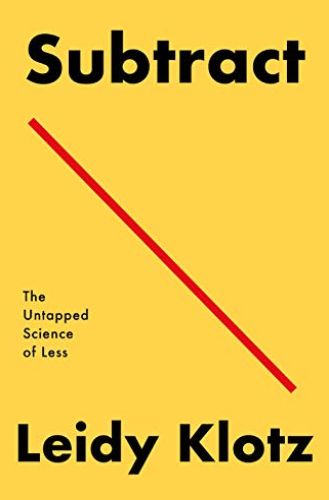Behavioral scientist Leidy Klotz builds a convincing case – with literary, scientific and historical examples – for the elegance and functionality of subtracting, not adding, in all aspects of life and thought.

More with Less
Leidy Klotz, the founder and director of the University of Virginia’s Convergent Behavioral Science Initiative, examines why people reflexively opt for more over less and argues that less often proves to be more. He explains – using myriad examples from numerous fields – how subtraction fuels positive change in personal psychology, human interaction, consumerist culture and planet Earth.
Subtraction
Klotz tells how, for almost a decade, city planner Sue Bierman studied the proposed benefits of removing the Embarcadero Freeway, which blocked the eastern waterfront of San Francisco. Tens of thousands of vehicles traveled the freeway every day, however. Despite the support of the city planning commission, voters vetoed Bierman’s proposal. In 1989, the Loma Prieta earthquake struck, damaging the Embarcadero Freeway beyond repair. After the city subtracted the highway, the Embarcadero became one of San Francisco’s most popular tourist destinations.
Subtraction is the act of getting to less, but it is not the same as doing less. In fact, getting to less often means doing, or at least thinking, more.Leidy Klotz
When making a change, people tend to default to adding to an existing object, idea or process. While addition is not necessarily evil, failing to subtract can lead to negative outcomes: A surfeit of objects burdens people’s homes, for example, rules and regulations bog down institutional processes, and entrenched notions drive building on existing ideas rather than considering their flaws. Fortunately, says Klotz, with effort, it’s possible to acknowledge subtraction neglect and use it to inspire change.
Subtraction Gets Overlooked
When building a Lego bridge with his three-year-old son, Klotz instinctively added a block to make the supports equal, while his son subtracted one. Klotz began to wonder if people generally neglect subtraction as an option for change. He and a team of researchers conducted a series of experiments to evaluate how often participants used subtraction to improve a structure, a piece of music or a busy itinerary. Their findings showed that subjects overwhelmingly opted to add more often than they subtracted. In fact, until prompted, most subjects failed to recognize subtraction as an option. Why?
Obstacles to Subtraction
Humans boast an innate drive to control their environment and a biological need to demonstrate competence. This explains why it feels so satisfying to check items off a to-do list, for example. Examining early human behavior provides clues as to why humans are more apt to add than to subtract. Some 40,000 years ago, hunting and gathering was pivotal to survival. Humans remain wired to accumulate, Klotz explains, even though finding food is no longer a full-time job.
When the Collyer brothers died in their New York City brownstone in 1947, police found decades of stuff, piled to the ceiling. These hoarders exhibited an extreme proclivity toward “acquisitiveness” – a biological instinct to add. Neuroscientists have found a link between acquiring and feeling pleasure, substantiating the deep-rooted human need to add.
Klotz outlines an experiment by Harvard professor Elizabeth Spelke, which found that kids sense the difference between more and less, even before they learn math. When children learn to connect the abstract idea of a number to a physical object, they develop a set schema to visualize concepts such as less or more. However, the concept of negative numbers is exceedingly difficult for children to grasp. These three elements – set schema, the biological instinct to add, and the satisfaction of demonstrating competence – all work against viewing subtraction as a viable change agent.
Unchecked Consumerism
As civilizations form, material culture follows. People begin accumulating objects that make life easier, and societies add frameworks for living together, such as laws, religion and ways to share ideas. Klotz cites philosopher Adam Smith, who argued that economic growth benefits the greatest number of people and referred to economic growth as a patriotic duty. Economist John Maynard Keynes also framed individual consumption as serving the greater good.
In our striving to improve our lives, our work and our society, we overwhelmingly add.Leidy Klotz
Yet, Klotz proposes, subtraction has immense profit potential. For instance, when Ryan McFarland reengineered a bike for his two-year-old, he considered which parts to eliminate. He removed the drive train and pedals, thus creating the Strider bike.
Satisficing
People rarely attempt to fix things that don’t seem broken. Nobel Prize winner Herbert Simon calls settling for good enough “satisficing.” Satisficing is a reasonable time-saver, but it can impede more helpful subtraction-related thoughts or actions.
Stopping at good enough protects us from wasting effort, but if we are not careful, the same tendency can prevent us from subtracting when the effort would pay off.Leidy Klotz
Many authors, including Mark Twain and Ernest Hemingway, applaud using fewer words. Fans of Marie Kondo embrace subtraction when following her home-tidying advice, which encourages getting rid of possessions that don’t “spark joy.”
Humans have a biological limit on much they can absorb and process. While filtering, sorting and summarizing help to organize information, it doesn’t reduce the amount vying for your attention. Klotz recommends practicing selecting what is most relevant to you. Intentional subtraction reduces mental overload and relieves stress.
Nurturing the Planet
The principles of subtraction can aid the planet, Klotz posits. Costa Rica, for example, prioritized becoming a carbon-neutral nation by 2021, a choice that informs every decision regarding budgets, regulations and incentives and thus, inspires subtracting. Costa Rica benefits from its subtractions because drawing carbon dioxide from the atmosphere sustains its rain forests, which provide a habitat for local species and draw tourists.
Review
Klotz provides myriad examples to illustrate his theme, which he could state as a sentence. Some readers might argue Klotz could have applied subtraction principles to his text, but, despite the clutter, Klotz’s concepts make a strong case for subtraction. His enthusiasm shines through, as does his articulate curiosity about human nature and the forces that drive irrational choices.
Other books on doing more with less include Marie Kondo’s The Life-Saving Magic of Tidying Up, Joshua Becker’s The More of Less and Daniel Kahneman’s Noise.





